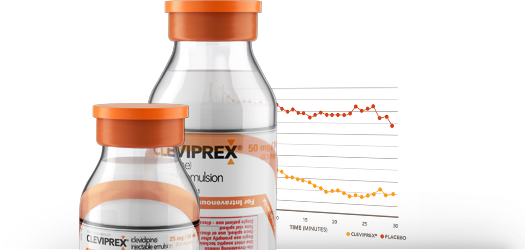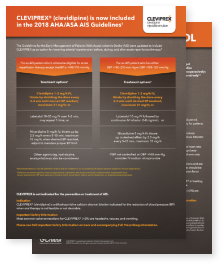CLEVIPREX® (clevidipine) provides BP reduction in a range of patients and clinical settings

CLEVIPREX efficacy was evaluated across 4 clinical studies1-5
See the results of each clinical study below.
ESCAPE-1: Preoperative hypertension
Responsive BP reduction within minutes in the preoperative clinical setting1,2
92.5% of patients on CLEVIPREX achieved treatment success2*
The primary endpoint was the incidence of treatment failure, defined as the inability to decrease systolic blood pressure (SBP) by ≥15% from baseline or the discontinuation of study treatment for any reason within the 30 minutes after study drug initiation.2
*Treatment success was defined as a reduction of SBP of ≥15% from baseline within the 30 minutes after study drug initiation.
Target SBP reduction (≥15% from baseline) achieved within a median time of 6 minutes2
ESCAPE-1 (Preoperative Hypertension) Study Design2
| Study type | Randomized, double-blind, placebo-controlled, phase 3 study |
| Purpose | To determine the safety and efficacy of CLEVIPREX in treating preoperative hypertension |
| Patient population |
|
| Key inclusion criteria | SBP ≥160 mm Hg and clinically assessed as needing ≥15% reduction in SBP |
| Protocol |
|
Recommended in Stroke Guidelines
CLEVIPREX has been recommended in the AHA/ASA Acute Ischemic Stroke Guidelines since 2018.6

ESCAPE-2: Perioperative hypertension
High rate of treatment success in the postoperative clinical setting1,3
91.8% of patients on CLEVIPREX achieved treatment success3*
The primary endpoint was the incidence of treatment failure, defined as the inability to decrease SBP by ≥15% from baseline or the discontinuation of study treatment for any reason within the 30 minutes after study drug initiation.3
*Treatment success was defined as a reduction of SBP of ≥15% from baseline within the 30 minutes after study drug initiation.
Target SBP reduction (≥15% from baseline) achieved within a median time of 5.3 minutes3
†The decrease in the placebo group’s SBP reflects the number of placebo patients (N=49 at baseline) who bailed out during the 30-minute infusion period (N=10 remaining at 30 minutes).
ESCAPE-2 (Postoperative Hypertension) Study Design3
| Study type | Randomized, double-blind, placebo-controlled, phase 3 study |
| Purpose | To determine the safety and efficacy of CLEVIPREX in treating postoperative hypertension |
| Patient population |
|
| Key inclusion criteria | SBP ≥140 mm Hg and clinically assessed as needing ≥15% reduction in SBP |
| Protocol |
|

VELOCITY: Severe hypertension
Control of acute severe hypertension with low rate of overshoot4
Nearly 89% of patients with acute severe hypertension achieved target BP range4*
- Target SBP range achieved within a median time of 10.9 minutes4
- No change in lipid profile was observed4†
- Mean duration of infusion was 21 hours1,4
*mITT population, n=117.
†Increased blood triglycerides have been observed in the postmarketing experience of CLEVIPREX.
Low rate of overshoot‡ in patients with acute severe hypertension4
- 1.6% of patients (n=2) experienced overshoot within the first 3 minutes after start of infusion. These 2 patients continued CLEVIPREX infusion beyond 18 hours without experiencing any adverse events (AEs)4
- In this study, the incidence of AEs leading to study drug discontinuation was 4.8%1
‡Overshoot was defined as SBP below the prespecified initial target range within the first 3 minutes of starting the infusion.
CLEVIPREX safety data in acute severe hypertension
- Serious AEs from CLEVIPREX initiation to 7 days later were reported in 11 of 126 (8.7%) safety population patients4
- Headache was the most frequently reported AE, with an overall incidence of 6.3% (8 of 126), followed by nausea 4.8% (6 of 126), chest discomfort 3.2% (4 of 126), and vomiting 3.2% (4 of 126)4
- The incidence of AEs leading to study drug discontinuation for CLEVIPREX in severe hypertension was 4.8%1
VELOCITY (Acute Severe Hypertension) Study Design4
| Study type | Open label, single arm |
| Purpose | To determine the safety and efficacy of CLEVIPREX in treating severe hypertension |
| Patient population |
|
| Key inclusion criteria | SBP >180 mm Hg or diastolic blood pressure [DBP] >115 mm Hg |
| Protocol7 |
|
Dr. Horowitz speaks about CLEVIPREX
Renowned anesthesiologist Dr. Todd Horowitz discusses CLEVIPREX clinical trial results and dosing in a series of informative videos for healthcare professionals.
ACCELERATE: Intracerebral hemorrhage
Median time to achieve target SBP range was 5.5 minutes5
All patients achieved target SBP within 30 minutes5
- 96.9% achieved target SBP with CLEVIPREX monotherapy5
- Mild/moderate hypotension was reported in 3 patients and resolved with dose reduction or drug discontinuation5
Mean (±SE) change in SBP with clevidipine (mITT population=33).
Mean baseline SBP=186 mm Hg.
CLEVIPREX is not indicated for the prevention or treatment of stroke.
What AIS Guidelines say to look for in BP control
Since 2018, the Guidelines for the Early Management of Patients With Acute Ischemic Stroke (AIS) have recommended CLEVIPREX as an option for lowering arterial hypertension before, during, and after acute reperfusion therapy. View moreACCELERATE (ICH) Study Design5
| Study type | Multicenter, prospective, open-label, pilot, phase 3b study |
| Purpose | Evaluate the efficacy and safety of CLEVIPREX in managing hypertension (SBP >160 mm Hg) in patients presenting within 6 or 12 hours of symptom onset with ICH |
| Patient population | N=35 |
| Key inclusion criteria |
|
| Protocol7 |
|
Demonstrated safety profile
CLEVIPREX safety has been established in multiple clinical trials, including comparative studies.8
View moreReferences: 1. CLEVIPREX® (clevidipine) Prescribing Information. 2021. 2. Levy JH, Mancao MY, Gitter R, et al. Clevidipine effectively and rapidly controls blood pressure preoperatively in cardiac surgery patients: the results of the randomized, placebo-controlled efficacy study of clevidipine assessing its preoperative antihypertensive effect in cardiac surgery-1. Anesth Analg. 2007;105(4):918-925. 3. Singla N, Warltier DC, Gandhi SD, et al; ESCAPE-2 Study Group. Treatment of acute postoperative hypertension in cardiac surgery patients: an efficacy study of clevidipine assessing its postoperative antihypertensive effect in cardiac surgery-2 (ESCAPE-2), a randomized, double-blind, placebo-controlled trial. Anesth Analg. 2008;107(1):59-67. 4. Pollack CV, Varon J, Garrison NA, Ebrahimi R, Dunbar L, Peacock WF. Clevidipine, an intravenous dihydropyridine calcium channel blocker, is safe and effective for the treatment of patients with acute severe hypertension. Ann Emerg Med. 2009;53(3):329-338. 5. Graffagnino C, Bergese S, Love J, et al. Clevidipine rapidly and safely reduces blood pressure in acute intracerebral hemorrhage: the ACCELERATE trial. Cerebrovasc Dis. 2013;36(3):173-180. 6. Powers WJ, Rabinstein AA, Ackerson T, et al; American Heart Association Stroke Council. 2018 Guidelines for the Early Management of Patients with Acute Ischemic Stroke: a guideline for healthcare professionals from the American Heart Association/American Stroke Association. Stroke. 2018;49(3):e46-e110. 7. Data on file. Chiesi USA, Inc. 8. Aronson S, Dyke CM, Stierer KA, et al. The ECLIPSE trials: comparative studies of clevidipine to nitroglycerin, sodium nitroprusside, and nicardipine for acute hypertension treatment in cardiac surgery patients. Anesth Analg. 2008;107(4):1110-1121.
Open
Close
The information provided in this website is intended for US healthcare professionals only.
I certify that I am a US healthcare professional.